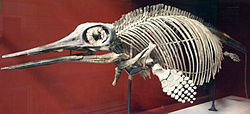オフタルモサウルス
| オフタルモサウルス | ||||||||||||||||||||||||||||||
|---|---|---|---|---|---|---|---|---|---|---|---|---|---|---|---|---|---|---|---|---|---|---|---|---|---|---|---|---|---|---|
 オフタルモサウルスの骨格標本
| ||||||||||||||||||||||||||||||
| 地質時代 | ||||||||||||||||||||||||||||||
| ジュラ紀 | ||||||||||||||||||||||||||||||
| 分類 | ||||||||||||||||||||||||||||||
| ||||||||||||||||||||||||||||||
| シノニム | ||||||||||||||||||||||||||||||
| ||||||||||||||||||||||||||||||
| 種 | ||||||||||||||||||||||||||||||
|
オフタルモサウルス(学名:Ophthalmosaurus)は、1億6500万年前から1億6000万年前にあたる中生代ジュラ紀後期に生息していた魚竜の1属。全長約6メートルでイルカに類似した姿をしており、歯のない顎はイカの捕食に適していた。主な化石はヨーロッパと北アメリカに分布している。
形態
[編集]
オフタルモサウルスの体型は雫に似ており、尾ビレは半月状であった。前肢は後肢よりも発達しており、尾ビレで推進力を得て前肢で調整していたとみられている。
半月型の発達した尾鰭を持っていたと推測されている。オフタルモサウルスの特徴としては、体と目の大きさの比率が大きく直径22 - 23センチメートルに達する点が挙げられる[2][3]。眼球は頭部のほぼ全ての空間を占め、水圧に対し眼球の構造を維持していたとみられる強膜輪により保護されていた[4]。目と強膜輪の大きさから、オフタルモサウルスは日光のあまり届かない場所あるいは獲物が活発になる夜に狩りをしていたことが示唆されている。
発見と種
[編集]アパトドントサウルス属、アンカナムニア属、バプタノドン属、モレサウルス属、パラオフタルモサウルス属、ウンドロサウルス属、ヤシコヴィア属は2000年の Maisch と Matzke の論文ではオフタルモサウルス属のジュニアシノニムと考えられていた[1]が、後の分岐学的解析によりモレサウルス属はオフタルモサウルス科の有効な属であることが判明した[2][3][4]。オフタルモサウルス・ナタンスはオフタルモサウルスの模式種よりも他のオフタルモサウルス亜科に近縁であることが分かり[2][4][5]、唯一利用可能な学名であるバプタノドン属の復活が必要とされている。ウンドロサウルス属の有効性は数多くの論文著者が認めており、ジュニアシノニムとした Maisch までも有効性を受け入れている[3][6][7][8][9]。さらにロシアの分類群2つも有効な属である可能性がある[3][8] Ophthalmosaurus chrisorum(Russell, 1993)は2010年にマクスウェルにより独自の属であるアースロプテリギウス属に移された[10]。パラオフタルモサウルスとヤシコヴィアについてはオフタルモサウルスとは異なり明らかに有効な属である[11][12]。
分類
[編集]
オフタルモサウルス科において、オフタルモサウルスはアエギロサウルスと最も近縁と考えられていた[13]。しかし後の分岐学解析によりオフタルモサウルスはモレサウルスとアカンプトネクテスの間に位置付けられている。アエギロサウルスはプラティプテリギウスに近縁でありオフタルモサウルス亜科には属していないと判明している[3][4]。
下のクラドグラムは Fischer らの2013年の論文に基づく[14]。
| トゥンノサウルス類 |
| |||||||||||||||||||||||||||||||||||||||||||||||||||||||||||||||||||||||||||||||||||||||||||||
生態
[編集]
オフタルモサウルスは一般に20分以上潜水可能だったと計算されている[5]。遊泳速度は秒速2.5メートルと推定されているが、秒速1.0メートルという控えめな速度で見積もっても、オフタルモサウルスは水深600メートルまで潜って20分以内に水面に顔を出すことが可能である。
オフタルモサウルスの関節の骨からは減圧症の証拠が見つかっており、おそらく捕食者からの回避戦術のために生じたものとされている。現代のクジラは捕食者から逃れるために急上昇する際に減圧症を発症することが知られている[16]。
出典
[編集]- ^ Maisch MW, Matzke AT. 2000. The Ichthyosauria. Stuttgarter Beiträge zur Naturkunde Serie B (Geologie und Paläontologie) 298: 1-159.
- ^ a b Patrick S. Druckenmiller and Erin E. Maxwell (2010). “A new Lower Cretaceous (lower Albian) ichthyosaur genus from the Clearwater Formation, Alberta, Canada”. Canadian Journal of Earth Sciences 47 (8): 1037–1053. Bibcode: 2010CaJES..47.1037D. doi:10.1139/E10-028.[リンク切れ]
- ^ a b c d Fischer, Valentin; Edwige Masure; Maxim S. Arkhangelsky; Pascal Godefroit (2011). “A new Barremian (Early Cretaceous) ichthyosaur from western Russia”. Journal of Vertebrate Paleontology 31 (5): 1010–1025. doi:10.1080/02724634.2011.595464.
- ^ a b c Valentin Fischer; Michael W. Maisch; Darren Naish; Ralf Kosma; Jeff Liston; Ulrich Joger; Fritz J. Krüger; Judith Pardo Pérez et al. (2012). “New Ophthalmosaurid Ichthyosaurs from the European Lower Cretaceous Demonstrate Extensive Ichthyosaur Survival across the Jurassic–Cretaceous Boundary”. PLoS ONE 7 (1): e29234. Bibcode: 2012PLoSO...729234F. doi:10.1371/journal.pone.0029234. PMC 3250416. PMID 22235274.
- ^ Ilaria Paparella; Erin E. Maxwell; Angelo Cipriani; Scilla Roncacè; Michael W. Caldwell (2017). "The first ophthalmosaurid ichthyosaur from the Upper Jurassic of the Umbrian–Marchean Apennines (Marche, Central Italy)". Geological Magazine. 154 (4): 837–858. doi:10.1017/S0016756816000455.
- ^ Storrs, Glenn W.; Vladimir M. Efimov; Maxim S. Arkhangelsky (2000). “Mesozoic marine reptiles of Russia and other former Soviet republics”. In Benton, M.J.; Shishkin, M.A.; and Unwin, D.M.. The Age of Dinosaurs in Russia and Mongolia. Cambridge: Cambridge University Press. pp. 140–159. ISBN 9780521545822
- ^ McGowan C, Motani R. 2003. Ichthyopterygia. – In: Sues, H.-D. (ed.): Handbook of Paleoherpetology, Part 8, Verlag Dr. Friedrich Pfeil, 175 pp., 101 figs., 19 plts; München
- ^ a b Michael W. Maisch (2010). “Phylogeny, systematics, and origin of the Ichthyosauria – the state of the art”. Palaeodiversity 3: 151–214.
- ^ Fischer, V.; A. Clement; M. Guiomar; P. Godefroit (2011). “The first definite record of a Valanginian ichthyosaur and its implications on the evolution of post-Liassic Ichthyosauria”. Cretaceous Research 32 (2): 155–163. doi:10.1016/j.cretres.2010.11.005.
- ^ Maxwell, E.E. (2010). “Generic reassignment of an ichthyosaur from the Queen Elizabeth Islands, Northwest Territories, Canada”. Journal of Vertebrate Paleontology 30 (2): 403–415. doi:10.1080/02724631003617944.
- ^ Storrs, Glenn W., Maxim S. Arkhangel'skii, and Vladimir M. Efimov. 2000. Mesozoic marine reptiles of Russia and other former Soviet republics. In: Michael J. Benton, Michael A. Shishkin, David M. Unwin, and Evgenii N. Kurochkin (eds.), The Age of Dinosaurs in Russia and Mongolia, Cambridge University Press, pp. 187-210.
- ^ N. G. Zverkov, M. S. Arkhangelsky and I. M. Stenshin (2015) A review of Russian Upper Jurassic ichthyosaurs with an intermedium/humeral contact. Reassessing Grendelius McGowan, 1976. Proceedings of the Zoological Institute 318(4): 558-588
- ^ Fernández M. 2007. Redescription and phylogenetic position of Caypullisaurus (Ichthyosauria: Ophthalmosauridae). Journal of Paleontology 81 (2): 368-375.
- ^ Fischer, V.; Arkhangelsky, M. S.; Uspensky, G. N.; Stenshin, I. M.; Godefroit, P. (2013). “A new Lower Cretaceous ichthyosaur from Russia reveals skull shape conservatism within Ophthalmosaurinae”. Geological Magazine 151: 1. doi:10.1017/S0016756812000994.
- ^ Arkhangel’sky, M. S., 1998, On the Ichthyosaurian Genus Platypterygius: Palaeontological Journal, v. 32, n. 6, p. 611-615.
- ^ Cannon, John. 2007. Why Do Whales Get the Bends?. ScienceNOW Daily News. [1].
